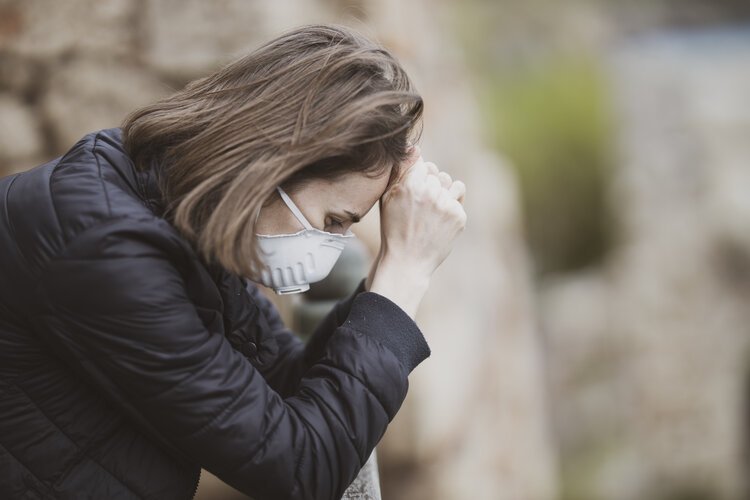A Practical Evidence-Based Self-Help Program for COVID-19-Related Worry and Anxiety
Session One: On Anxiety
Prepared by Nicole Carter, MSW, RSW
Please do not copy or distribute this material without permission.
Why Anxiety Makes Sense During a Global Crisis
A global crisis can strip us of our agency, present threats we were not predicting, and create layers of loss that can elicit unfamiliar thoughts, feelings, and behaviours. According to Dr. Gordon Neufeld, COVID-19 can:
Remind us of our mortality
Threaten our hopes, plans, dreams, and possessions
Create a loss of roles, routines, and places
Create a loss of familiarity
Challenge our ideas of predictability, certainty, security, and safety
Elicit strong feelings as a result of the loss of togetherness and attachment to those we love
Fill us with alarm, frustration, and pursuit
One particularly difficult aspect of COVID-19 can be the loss of togetherness. Given that closeness with others is a survival instinct that most of us are born with, having this threatened can leave us feeling stressed, frustrated, and confused. It is not easy for our brains to process or accept the idea that togetherness is actually the threat, rather than the remedy, during a crisis. In other crises, humans tend to gravitate towards each other, even if that means putting themselves in more danger (for example, you might see this behaviour during war, 9/11, a house fire, a natural disaster, or a motor vehicle accident). But COVID-19 demands isolation and physical distancing, forcing many of us to face this crisis without our familiar support networks.
Given the broad impact of this pandemic, a level of anxiousness is undoubtedly expected and in some ways even helpful. This session will discuss the nature of anxiety, what it might look like when it grows beyond what is helpful, and how our thoughts, feelings, and behaviours work together to create (and in some cases, worsen) our experience of anxiety.
The Nature of Anxiety
Anxiety is Normal & Adaptive
Anxiety in general is a normal, adaptive experience that can help keep us safe and alive. If we didn’t have anxiety, we might not study for tests or exams, prepare for presentations, perform optimally in sport, look both ways before crossing the street, or avoid harmful threats like a black bear on a hike. For many of us, COVID-19 can pose threats to our physical and mental health, safety, and stability, which would understandably create new or worsening anxiety and worry about the uncertainty of the future. When, then, does our anxiety become “too much”?
Three Components of Anxiety
Thoughts, Feelings, and Behaviours
Anxiety is a cluster of thoughts and hypotheses, feelings and sensations, and behaviours that can all influence each other in a bidirectional way. Our thoughts can influence our feelings and sensations, which then influence how we behave. The way we behave can then circle back to influence how we think, the things we believe and conclusions we draw, the predictions and assumptions we make, and how we feel. Sometimes this process is helpful - for example, when our thoughts about contracting COVID-19 or getting someone else sick with COVID-19 create anxiety and fear, leading to physical distancing and more frequent hand-washing. Other times, though, the way we think about and behave towards COVID-19 might unintentionally create more, or unnecessary, fear and anxiety.
The Bidirectional Model of Anxiety
Thoughts, Feelings, and Behaviours Work Together to Create an Experience of Anxiety
Below is a generalized cognitive behavioural model of how COVID-19-related anxiety and worry might be experienced by some of us. As the arrows indicate, our thoughts can influence our feelings and behaviours, and the way we behave can circle back to further influence our thoughts and feelings.
For example, if we are very anxious and afraid that we will lose a family member to COVID-19, we might engage in behaviours such as excessive reassurance-seeking (texting our family member multiple times a day to check for symptoms or to ensure that they have not left their home), excessive media intake or researching, excessive COVID-19 test-taking, or googling stories that might confirm our fears or make our fears feel more probable than they actually are. These behaviours can give our hypotheses, predictions, and interpretations more strength, making them feel more likely or meaningful than what might be accurate or helpful (a mind trap often called emotional reasoning, when we draw [sometimes inaccurate] conclusions from our emotions).
Self-help Exercises
Consider dismantling your anxiety experiences by separating the situations in terms of thoughts, feelings and sensations, and behaviours.
Consider becoming aware of triggers, thoughts, feelings and behaviours (both helpful and unhelpful) throughout the day by tracking them in a journal or in the notes section of your smartphone anytime you notice a shift in anxiety or mood. Notice if there are any correlations between feeling more anxious and engaging in anxious thinking or behaving.
Anxiety Can Grow Beyond What is Helpful
Anxiety and worry during times of increased threat or uncertainty can certainly be normal and helpful. For example, on a macro level, institutions globally are executing an unprecedented level of preparedness that can help mitigate negative outcomes; on a micro level, individuals around the world are subscribing to robust hygiene routines and physical distancing as a measure to avoid the risk of contracting and spreading COVID-19. Given this, I think it’s safe to say that most of us are probably experiencing a higher than usual level of anxiety at the moment. Anxiety about real, current problems can help us plan, problem-solve, and develop goals that can serve us and others in a helpful and adaptive way.
Sometimes, though, our anxiety can grow beyond what is helpful, leading to thinking that might be unrealistic, inaccurate, or unhelpful, a feeling of intense panic or paralysis, or actions that inadvertently worsen our anxiety (even if it feels like those actions are helping us to stay calm in the moment).
Below is a diagram that can help us identify if our anxiety is growing beyond what is helpful in terms of disproportion, impairment, and severity.
As an example, take an understandably worried partner whose partner works in healthcare. He might be thinking, What if my partner is in direct contact with someone who has contracted COVID-19? What if he doesn’t have access to PPE? What if he accidentally touches his face during or after his shift? What if he dies and I cannot visit him? What if he gets me, his family, or my family sick? What if I make him sick without knowing it? What if he then gets others sick because of me? Given these thoughts, he might be having a difficult time falling asleep, feeling nervous, anxious, and on edge, and maybe experiencing sensations such as chest tightness, derealization, and an increased heart rate.
Because these feelings and this sense of uncertainty are so uncomfortable, he might engage in the following behaviours to help relieve these feelings:
Texting his partner multiple times a day to inquire about his contact with possible COVID-19 patients, his health and symptoms, and his access to PPE
Checking the news and statistics in their area repeatedly to see if there have been any additional confirmed cases
Reading excessively about the nature of COVID-19 and reminding his partner daily how to maintain his health and safety
Subtly seeking reassurance from others by eliciting their opinions about healthcare workers’ health outlooks
Procrastinating tasks that need to get done due to spending a lot of time worrying, researching on his phone, and watching the news on television
While these behaviours make a lot of sense given his concerns about his partner, is it possible that some of these behaviours could be elevating his anxiety and worry, rather than relieving it? Does engaging in these behaviours necessarily make bad outcomes less likely? Is it possible that behaving in these ways might reinforce some of his fears, or make them feel more likely to occur? Does worrying about these things necessarily serve him or his partner in a helpful way? Can our actions actually increase certainty in life? In the next three sessions, we will discuss how worry, thoughts, and uncertainty - and the associated behaviours - can impact our level of distress.
Examples of How Covid-19 Might Affect Different Mental Health Disorders/Difficulties
Generalized Anxiety Disorder
Uncontrollable worry and anxiety about yourself or a loved one contracting and/or dying from COVID-19
Worry about various COVID-19-related future events, such as loss of job, home, relationships, and so on that might not have much evidence and would likely be improbable
Excessive reassurance-seeking, checking, and feeling intolerant of the uncertainty of COVID-19 beyond what might be reasonable
Feeling easily fatigued, having difficulty concentrating or sleeping/staying asleep, feeling irritable and/or experiencing muscle tension
Social Anxiety Disorder
Relief surrounding having to engage in less social interaction and therefore reduced perceived criticism or post-event processing
Reduced performance anxiety due to increased virtual contexts for work and school
Increased anxiety when faced with smaller Zoom breakout rooms
Increased anxiety when having to speak louder in public due to mask-wearing
Panic Disorder
Increased hypervigilance of physical sensations and symptoms in your body, leading to confusion or fear surrounding the meaning behind the sensations
Fears of waiting in lines at stores, wearing a mask due to breathlessness, dizziness, heat and other sensations
Illness Anxiety Disorder
Feeling preoccupied with having or getting COVID-19
Feeling extra hypervigilant about bodily sensations and symptoms that could indicate COVID-19
If mild symptoms do exist (for example, a headache), excessive fear about developing COVID-19
Frequent reassurance-seeking, COVID-19 testing, googling, or checking (oximeter readings, temperature, etc)
Separation Anxiety Disorder
Worry about losing certain attachment figures or figures contracting and/or dying from COVID-19
Worry about contracting COVID-19 and therefore being separated from attachment figures
Nightmares about separating from loved ones because of COVID-19
School refusal behaviours due to fear of loved ones getting sick/the child getting sick themselves
Obsessive-Compulsive Disorder
Fears of being immoral or a “bad person” if you do not follow hygiene or COVID-19 instructions perfectly; fears about being responsible for someone contracting COVID-19
Persistent doubt about the presence of, or meaning behind, symptoms or sensations in your body
Persistent doubt about whether or not you washed your hands, sanitized, wore a mask, or followed other protocols properly
Fear of acting on thoughts or urges to cough or breathe on someone vulnerable
Excessive concern about germs, beyond what might be reasonable
Compulsive behaviours such as excessive hand washing or sanitizing beyond what is reasonable, ritualistic behaviour to try to thwart bad things from happening, reassurance-seeking such as excessive COVID-19 testing or calls to the public health centre in your area, excessive checking behaviours such as checking temperature or oximeter level or obsessively checking the news or case numbers in your area, and so on
Intrusive, unwanted thoughts or images of people dying of COVID-19
Magical thinking about how your actions may have the power to cause bad things to happen or prevent bad things from happening (for example, avoiding saying certain things as it could make someone you love get sick)
Excessive concern about and protection of loved ones who might be immunocompromised







